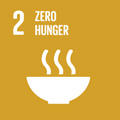- Docente: Lucia Vannini
- Credits: 5
- SSD: AGR/16
- Language: Italian
- Teaching Mode: Traditional lectures
- Campus: Cesena
- Corso: First cycle degree programme (L) in Sciences and Culture of Gastronomy (cod. 5808)
-
from Feb 20, 2025 to May 22, 2025
Learning outcomes
The aim of the course is to give the students information useful to predict the fate and microbial activities of beneficial, spoilage and pathogenic microorganisms in foods, and to understand their interactions within the environment-food-human ecosystem. Students will be given knowledge necessary to understand the role of microorganism in the production of traditional, typical and innovative foods, also through the valorisation of microbial biodiversity, and to assure food safety and quality
Course contents
The course includes both lectures and practical activities.
Lectures are aimed at providing students with knowledge to understand: i) the effects of technological processes, packaging and storage conditions on inactivation and growth of food relevant microorganisms; ii) role and metabolic activities of key microbial groups in foods involved both in spoilage and food fermentation; iii) potentials of predictive microbiology in assessing food safety, and predicting microbiological shelf-life and microbial activities for the production of fermented foods.
Lab and classroom practicals are aimed at providing students with the ability and training to perform microbiological analyses of foods, to critically analyse experimental data and case studies, to use mathematical models to predict food shelf-life.
Introduction to the course - presentation of the teacher, overview on the aims of the course, the topics addressed, how teaching material is provided to students and how the final examination is carried out.
Fermented foods - brief history, main characteristics and types of food fermentation; guided and spontaneous fermentations; microorganims most frequently involved/used for the production of fermented foods - role of various microbial starters and natural microbiota in the biochemical changes characterizing yoghur, kefir, salami, bread and sourdough, table olives, kombucha, soy sauce.
Food contamination and microbial growth in foods – retrieve of the main technological processes to reduce microbial contamination, strategies to control microbial growth in foods, microbial groups responsible for spoilage or relevant for food safety.
Challenge test and procedure to define the shelf-life – examples of possible usesin the gastronomy sector
Pedictive microbiology – aims, general concepts of predictive microbiology, possible uses in the food microbiology area. Types of models: primary models for microbial growth curves (Gompertz equation) and microbial inactivation (linear and nonlinear kinetics); secondary models – experimental designs to evaluate the combined effects of different variables on microbial growth parameters and microbial metabolism; tertiary models - software for predictive microbiology: COMbase
Lab and classroom practical activities - i) microbiological analyses to assess microbial inactivation following a technological process; ii) microbiological analyses to detect pathogens and assess the fate of main spoilage microorganisms over storage; iii) sourdough: estimation of lactic acid bacteria and yeasts, and detrmination of lactic/acetic acids; iv) experimental designs and microbial challenge tests; v) critical analysis and modelling of the experimental data to predict microbial shelf-life; vi) analyses of case studies and use of predictive microbiology for the assessment of food safety and prediction of food shelf-life and fermentation process by microbial sarters.
In consideration of the type of activities and teaching methods, the attendance at this training activity requires all students to carry out the Modules 1 and 2 in the e-learning mode [https://www.unibo.it/it/servizi-e-opportunita/salute-e-assistenza/salute-e-sicurezza/sicurezza-e-salute-nei-luoghi-di-studio-e-tirocinio] and participation in the Module 3 on specific training on safety and health in study places. Information on dates and mode of attendance for Module 3 can be acquired by consulting the specific section of the degree program website.
Readings/Bibliography
- Cocolin L., Gobbetti M., Neviani E. "MICROBIOLOGIA ALIMENTARE APPLICATA", Casa Editrice Ambrosiana
- Lecture notes provided by the teacher through the https://virtuale.unibo.it/ platform.
- Papers on specific topics suggested by the teacher
Teaching methods
Class lectures, laboratory practicals, classroom practicals, problem solving, analysis of case studies, seminars held by food sector experts
Assessment methods
The final assessment will be based on a wrtitten exam aimed at evaluating both knowledge on topics taught during class lectures and practical activities on: i) food fermentations and main fermented foods presented during classroom; ii) predictive microbiology with particular emphasis on the principal equations presented during the courses; iii) the ability to use the tools of the predictive microbiology to case studies to evaluate the effects of processes on food microbiota, to predict the shelf-life, to assess food safety and fermentation by microbial starters.
Durimg the written test, no lecture notes, books, PC, internet connection is allowed. The maximum time available for the test is 90 minutes. The test consists of different types of questions including open questions, multiple choiche questions, mute figures, exercises, definitions.... Scores will be clearly reported in the text close to each question. The written test is passed provided that a score of at least 18 points is reached.
The final grade for the integrated course of "Food Quality and Safety" will be calculated as weighted average of the scores obtained in the two courses "Microbiologia Predittiva Applicata alle Preparazioni Gastronomiche" (5 CFU) and "Formulazione, Trasformazione e Confezionamento dei Prodotti Enogastronomici" (Module 1, Prof.ssa Ricci - 3 CFU; Module 2, Prof. Rocculi - 2 CFU).
Prof.ssa Lucia Vannini is in charge for recording the final grade in AlmaEsami. Students must contact via e-mail Prof. Vannini to ask for recording their score.
Teaching tools
Slides of the lectures and training activities both in classroom and in the laboratory of Food Microbiology will be available as pdf files for all the enrolled students through the web-site: "Virtual Learning Environment"
Office hours
See the website of Lucia Vannini
SDGs



This teaching activity contributes to the achievement of the Sustainable Development Goals of the UN 2030 Agenda.
